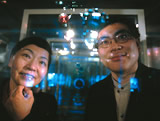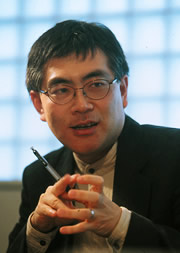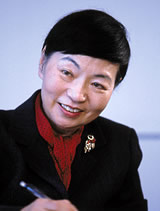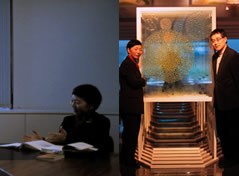| Biohistory journal,Spring, 2004: Index >Life: The universality of diversification |
| Dialogue/Philos The Philos of essence Life: The universality of diversification Kunihiko Kaneko and Keiko Nakamura | |
| |
| he existence of people capable of empathizing with the approach to scholarship is a major force driving the advancement of thought. One of these people is Professor Kaneko. He has the adaptability required to discern essence within the realm of physics, and he directly confronts the question, "What is life?". What is understanding? The approach of physics was not to pursue details, but to obtain a picture of the whole. That might well be the case for biology, too. (Keiko Nakamura) |
 |
 |
After the dialogue / Kunihiko Kaneko |
| I participated in the Biohistory Journal discussions that Keiko Nakamura planned almost 10 years ago. This was the first time since then that I had the chance to have a relaxed discussion. I sensed the points in common between the section about describing historicity in complex systems and the concept of the Biohistory. In contrast, I also sensed the gap between the concept of physics that tries to capture universality, and the sensibility of the biologist that wants to see the living creatures here today just as they are. In this dialogue, I was happy not only that Dr. Nakamura was able to understand the view of life from the standpoint of physics, but also that she elicited some differences. I always have the feeling when I talk to renowned biologists that I get a direct view of the essence of living creatures that originates in the continuous observation of those creatures in their element. In Dr. Nakamura's case, there is at the root a feeling of Philos for living creatures. But, even in physics, the impetus for wanting to understand the essence of living creatures comes from Philos. Rather, from understanding universality, I think the unique aspects--which become precious when their individuality and distinguishing characteristics emerge--are not the original aspects. (Ah, that last was a comment about a SMAP song.) |
|
| Some people are moved at the marvel of life itself, and some people are interested in the success of life through the continuous change. I tend to be in the latter camp. |
 |
When the dynamism of living creatures is considered, the essence of living creatures is continuous change. It is natural to think DNA have been somehow fixed. |
| The editor's note |
| This is our final discussion on the topic of Philos. We heard that Dr. Kaneko does not deal at all with actual living creatures, but conducts biological research using the concepts of physics. We were rather nervous, wondering what we would do if half of the conversation turned out to consist of mathematical expressions. We were relieved when he came to the hall, however, because the professor waxed nostalgic about the Mozambique Tilapia swimming in the tank (perhaps about their parallel evolution), noting that we had had an exhibition of the same fish before. We had the premonition that we would have the ultimate discussion about Philos. Of course, living creatures are made from matter, and their life activities undergo chemical changes. Still--life has yet to be defined. Research into complex systems, which attempts to apprehend the complexity of life, repeats the cycle of inquiry, logic, model, and experiment, and seems to have entered a very interesting phase. Molecular biology arose from the attempt to unravel life from the perspective of physics. It rapidly advanced to genome analysis, but also can tend to focus on enumeration for enumeration's sake. Professor Kaneko has returned to the starting point to consider the question, "What is life?". We had the sense that his view was identical to that of the Biohistory ---viewing life from the vantage point of evolution, generation, and the environment based on the cornerstones of universality and diversity--but from the opposite direction. There was a mutual pursuit of an indefinite form of life that floated between the macro and the micro. The flow of life is unceasing, and moreover, is not original life. We thought that the lyrics, "Bubbles floating languidly in a stream..." were indeed the way to describe us as living creatures. (Ah, the last comment was about Misora Hibari, or rather the Hojoki). |
| Kunihiko Kaneko Born in Kanagawa Prefecture in 1956, Dr. Kaneko received a degree from the Graduate School of Science at the University of Tokyo. He has worked as a researcher at the Los Alamos National Laboratory, Physics assistant in the College of Arts and Sciences at the University of Tokyo, and an assistant professor in basic sciences at the same university. He currently serves as professor of the Graduate School of Arts and Sciences at the University of Tokyo. His specialties are theological biology (complex systems), chaos, and non-equilibrium systems. |
| Dialogue |
|
Please close a window with the button of a browser who are turning off Javascript. |

